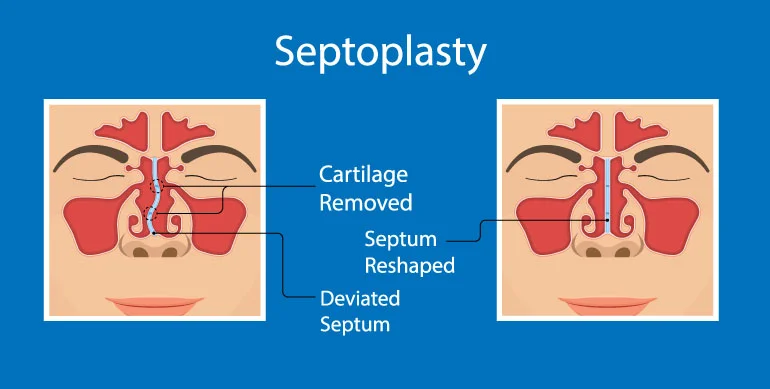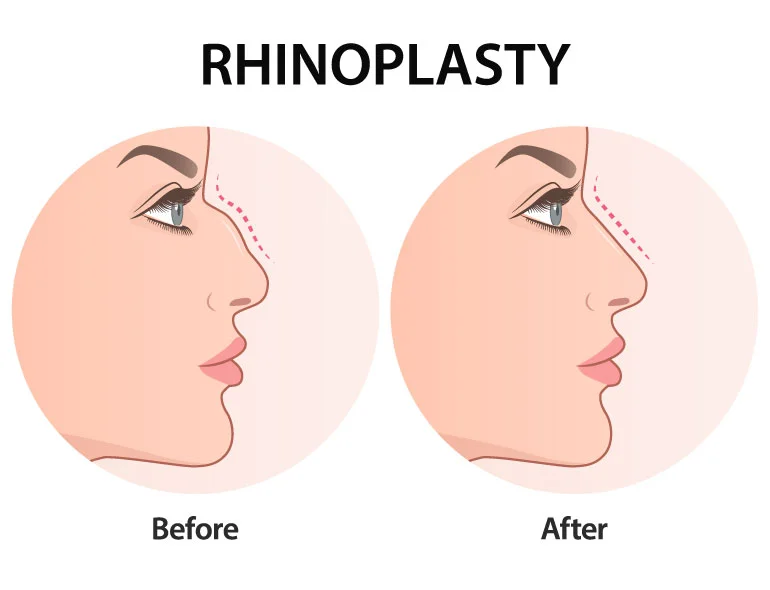Subscribe to get weekly insights
Always stay up to date with our newest articles sent direct to your inbox
Published on 20 Aug, 2025
Updated on 20 Aug, 2025
14 Views
7 min Read

Written by Sejal Singhania
Reviewed by Akhil Pillai
favorite0Like
favoriteBe the First to Like
Your nose plays a crucial role in your overall look. For both men and women, it’s often the most eye-catching feature. Because it’s so central to your appearance, any changes or issues with its shape and function are often more noticeable than with other parts of our face.
If you're concerned about your nose’s appearance or experiencing issues with its structure or function, two common surgeries can help: rhinoplasty and septoplasty.
While these procedures might sound similar, they are distinctly different. If you’re unsure which method is best for improving your nose's appearance, this blog will explain the differences between rhinoplasty and septoplasty. And also analyses whether septoplasty and rhinoplasty can be performed together.
Septoplasty is a surgery performed to correct a deviated septum, which is the cartilage and/or bone that separates the two nostrils. Imagine your nose as a house where the septum acts as the central wall maintaining balance. If this wall bends or shifts (called a deviated septum), it can block airflow and lead to issues such as:
Septoplasty does not change your nose's external appearance; it mainly straightens the septum to improve breathing.

In India, septoplasty surgery is generally quite affordable, with costs typically ranging from Rs 30,000 to Rs 1 lakh. Keep in mind that the actual price can vary depending on factors like the type of septoplasty, the hospital you choose, your surgeon’s experience, and whether you have health insurance. Traditional septoplasty usually costs between Rs 25,000 and Rs 45,000, while endoscopic septoplasty tends to be a bit more expensive, ranging from Rs 65,000 to Rs 75,000.
Consider septoplasty surgery if you're experiencing any of these symptoms:
Septoplasty is usually a safe and effective procedure. Just like any surgery, it does carry some risks, which include:
Your doctor might suggest some helpful tips to help you recover smoothly and avoid any unnecessary bleeding or complications. These are some tips to get a fast recovery from septoplasty surgery:
Recovery Tip: If you have a physically demanding job, like heavy lifting, taking 2 weeks off is advisable. A doctor can provide a note for your employer.
>> Also Read: Does Health Insurance Cover Deviated Septum Surgery?
As medical expenses continue to rise, surgeries can be financially challenging. However, with medical insurance coverage, you won't have to worry about costs. The price of deviated septum surgery may become quite affordable with insurance. Individual health insurance with Care Health Insurance offers financial support, allowing you to access high-quality cashless treatments without stress.
Care Health Insurance also covers daycare procedures, like septoplasty. These are surgeries or treatments that do not require hospital stays longer than 24 hours. For details on how much septoplasty costs with insurance or whether insurance covers septoplasty, contact our insurance experts for policy information and related clauses.
Rhinoplasty, commonly known as a nose job, is a surgical procedure that subtly alters the shape or size of the nose to help you feel more confident in your appearance. Whether for cosmetic reasons, improving breathing, or correcting structural issues from injury or congenital defects, this procedure involves carefully reshaping the bone and cartilage to achieve your desired look or function. Skilled surgeons specialising in plastic or facial plastic surgery perform these operations with care and expertise, ensuring you're in good hands.

Do you know that many actresses like Priyanka Chopra, Khloé Kardashian, and others have openly discussed undergoing rhinoplasty (a nose job) for various reasons, including cosmetic enhancement and functional improvements?
In India, rhinoplasty surgery is generally quite affordable, with prices usually between Rs 40,000 to Rs 2.5 lakh. Keep in mind that the actual cost can vary depending on factors such as the type of rhinoplasty, the hospital selected, the experience of the surgeon, and whether you have health insurance. Open rhinoplasty typically costs between Rs 80,000 to Rs 2.5 lakh, whereas closed rhinoplasty tends to be cheaper, ranging from Rs 40,000 to Rs 1.5 lakh. Revision rhinoplasty costs usually fall between Rs 2 lakh to Rs 3 lakh.
You might consider rhinoplasty to enhance your appearance and confidence. Those who need this surgery include:
All surgical procedures or plastic surgeries, like rhinoplasty, have risks. Some potential complications you might experience after rhinoplasty include:
To ensure your nose heals well during the first few weeks after rhinoplasty, here are some helpful tips to keep in mind:
Care Health Insurance understands the rising costs of medical care and the need for a comprehensive health plan. Therefore, surgeries for nasal function issues are part of the coverage. However, it is also essential to know which surgeries are excluded from health insurance.
The best health insurance policies do not cover nasal surgeries that are not medically necessary. Procedures like rhinoplasty, which aim to change the shape of the nose for cosmetic purposes, are not seen as medically necessary and are therefore not covered under health insurance. Only reconstructive surgeries that aim to restore the nose's original shape or fix nasal issues are covered.
If you're curious about whether insurance covers a nose job for a deviated septum, it's helpful to understand the different types of surgeries involved. Take a moment to review the simple comparison between rhinoplasty and septoplasty in the table below:
| Factors | Septoplasty | Rhinoplasty |
|---|---|---|
| Purpose and Indications | Septoplasty is performed to correct a deviated septum and enhance breathing, without significantly changing the appearance of the nose. | Rhinoplasty improves the nose's appearance. Combined with septoplasty, it also addresses breathing issues, called septorhinoplasty. |
| Surgical Techniques | Septoplasty involves an incision inside the nasal cavity to access the septum, allowing the surgeon to reposition or remove the deviated sections. | Rhinoplasty can be performed using open or closed approaches. The open method involves an incision across the columella, while the closed method makes incisions inside the nostrils. The surgeon reshapes the nasal bone and cartilage to achieve the desired look. |
| Recovery Time | Septoplasty typically involves a shorter recovery time, with most patients resuming normal activities within a week. Complete recovery usually occurs within 6-8 weeks. | Rhinoplasty involves a longer recovery time, with the initial healing taking 1-2 weeks and complete results becoming visible over several months to a year. |
| Cost and Insurance Coverage | Septoplasty is typically more affordable and often covered by insurance when done for medical reasons. | Rhinoplasty is generally more costly and usually not covered by insurance unless it is performed to correct functional problems. |
| Scarring | Septoplasty corrects a deviated septum and can cause minimal internal scarring, which may lead to nasal obstruction or asymmetry. | Rhinoplasty can leave scars, but their size and visibility depend on the surgical approach. Usually, scars are minimal and fade over time with proper care. |
For individuals aiming to improve their looks and breathing, having a rhinoplasty along with a septoplasty can be an excellent option. It's generally best to perform the cosmetic nose surgery before the septoplasty, as the septal cartilage may be restricted after the septoplasty, requiring the surgeon to take cartilage from the ear or other areas. Performing both surgeries at the same time is often the most practical choice, providing not just enhanced overall outcomes but also reduced expenses and shorter recovery time.
Nasal surgeries are common these days, especially with more people experiencing breathing problems, nasal polyps, and sinus issues caused by pollution. Getting treatment early on can help prevent more serious health problems down the line. If a deviated nasal septum is making it hard to breathe, septoplasty can be the best option to improve airflow and your overall quality of life. For those interested in cosmetic improvements, rhinoplasty is a great way to boost your appearance and self-confidence. Whatever your reason for considering nose surgery, it's always a good idea to consult with a skilled plastic or ENT surgeon. They can help you make the best decision and ensure everything turns out as positively as possible.
Disclaimer: The above information is for reference purposes only. Kindly consult your general physician for verified medical advice. The health insurance benefits are subject to policy terms and conditions. Refer to your policy documents for more information.
favoriteBe the First to Like
शुगर कंट्रोल कैसे करे? जानें, डायबिटीज में क्या खाना चाहिए Vipul Tiwary in Health & Wellness
Thyroid : मामूली नहीं हैं महिलाओं में थायराइड होना, जानें इसके लक्षण और घरेलू उपचार Vipul Tiwary in Diseases
हाई ब्लड प्रेशर को तुरंत कंट्रोल कैसे करें? देखें इसके उपाय Vipul Tiwary in Diseases
प्लेटलेट्स की कमी के लक्षण, कारण और इलाज क्या है Vipul Tiwary in Diseases
10 Reasons Why Your Joint Hurts Nidhi Goyal in Diseases
Struggling with Back Discomfort? Time to Rule Out Lumbar Lordosis Jagriti Chakraborty in Diseases
Decode Chikungunya Disease Before it Spreads Jagriti Chakraborty in Diseases
Why is Oat Milk Gaining Popularity: 7 Reasons Explained Jagriti Chakraborty in Diet & Nutrition